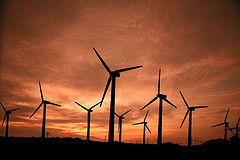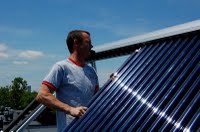 National Geographic has an interesting article about “the amount of life you can find in one cubic foot” of various ecosystems around the world. The article itself is short on details about the method, but beautifully written. For a description of the process watch the attached videos. Hint: It’s not an instantaneous cubic foot.
National Geographic has an interesting article about “the amount of life you can find in one cubic foot” of various ecosystems around the world. The article itself is short on details about the method, but beautifully written. For a description of the process watch the attached videos. Hint: It’s not an instantaneous cubic foot.
Tag Archives: video
I’m melting
A brief and interesting Google Earthy video of global ice loss.
Continue reading
Vacuum Tube Solar Hot Water Comes to Cambridge
One of the first home improvements Rachel and I made when we purchased our condo here in Cambridge this spring was a solar hot water installation on our rooftop.
The system we had put in uses vacuum tubes, a newer, more efficient type of solar collector than the black box flat panels of old. As a writer covering energy and the environment in Cambridge and China, I’d spent the past three years tracing this new and exotic technology back to the factories and cities in China where they are surprisingly commonplace.
I first read about the tubes three years ago in a story in the Boston Globe. A family in Newbury, MA was using a massive installation to provide hot water and heat for their giant barn of a house. A photo that went with the story showed their installation covered in frost on a cold winter day. Somehow, despite the cold, the tubes were still kicking out 120 to 160 degree water.
 The secret behind vacuum tubes that allows them to work just as well in winter as summer is, just as their name suggests, a vacuum space. The diagram at the right shows how the tubes work. Sunlight passes through a clear outer glass tube and travels through an evacuated space or vacuum where all of the air has been sucked out. The sunlight passes through this vacuum and then hits an inner black pipe that absorbs the sun’s rays converting the sunlight to heat. What’s key about all of this is that whereas light rays can pass through a vacuum space, heat can not. All of the heat is therefore trapped inside by this highly efficient, transparent insulator.
The secret behind vacuum tubes that allows them to work just as well in winter as summer is, just as their name suggests, a vacuum space. The diagram at the right shows how the tubes work. Sunlight passes through a clear outer glass tube and travels through an evacuated space or vacuum where all of the air has been sucked out. The sunlight passes through this vacuum and then hits an inner black pipe that absorbs the sun’s rays converting the sunlight to heat. What’s key about all of this is that whereas light rays can pass through a vacuum space, heat can not. All of the heat is therefore trapped inside by this highly efficient, transparent insulator.

After I read the story in the Globe I found out that there are thousands of factories kicking out these tubes in China and roughly 1 in 10 Chinese people use them for their hot water.
Six months after first hearing of the tubes, I toured the R&D center of one of these factories in Beijing for a story I wrote for New Scientist.
The story also led me to Rizhao, a city on the coast between Beijing and Shanghai where 99 percent of residents get their hot water from the sun. Here is a video I made from a rooftop of the city while talking with Rizhao’s mayor, Li Zhaoqian.
By the time we had a chance to buy a place of our own I was totally sold on the technology and couldn’t wait to put the tubes in on our own place. Evacuated tubes are still hard to come by in the US, however, and most of the installers I spoke with insisted they were no better than the flat panel solar collectors that had been around since the 70s. The estimates I got for flat panel installations, however, were twice the size of what I figured I could get by with using vacuum tubes. Then I found Bruce, a contractor with New England Solar Hot Water, who, like his company’s name suggests, only does solar hot water installations. Bruce and his crew had been doing vacuum tube installs for years and were stoked to hear I’d actually toured some of the factories where they get their parts.

In mid June they installed the collectors shown on the right that heat all of our domestic hot water; the water we use for showers, laundry, and in our sinks. The system is backed up by natural gas but on a sunny day like today, its unlikely we’ll need it. At 9am, with an outside temp of 43 F, our tubes are already a toasty 95 F and climbing.
Wind Electricity in Denmark
 In honor of the upcoming climate change conference in Copenhagen, I have decided to write a bit about the highly-evolved Danish wind-generation network. Danes – it’s OK if you thank me later.
In honor of the upcoming climate change conference in Copenhagen, I have decided to write a bit about the highly-evolved Danish wind-generation network. Danes – it’s OK if you thank me later.
The Danes generate a higher percentage of their electricity from wind than any other nation. Currently, wind supplies 20% of electricity in Denmark. Spain comes in second, and generates 12% of electricity from wind1. The U.S. generates 1% of its electricity from wind.
So what’s the deal? Why do the Danes have such a large lead in wind? There are two main reasons:
- Denmark is a small, geographically homogenous country with substantial wind resources and very limited solar and hydroelectric resources.
- As the video below explains, the Danes have chosen to design an electricity system that favors wind generation.
Reason #1 isn’t too complicated… Denmark is small and flat. No location is further than 52 km (32 miles) from the coast .
Reason #2 is more complex. As the video explains, the Danish government subsidizes wind generation and allows wind turbines to connect to the grid for free. Additionally, the Danish Grid is connected to Europe, so Danish power companies have the ability to sell excess wind-generation during times of surplus into an expanded network.
 Also, although the video states that wind is cheap, Danish residents pay among the highest prices for electricity in the World. So now the question is, can other countries use the Danish experience with wind as a template for their own plans?
Also, although the video states that wind is cheap, Danish residents pay among the highest prices for electricity in the World. So now the question is, can other countries use the Danish experience with wind as a template for their own plans?
And the answer: Yes… and No. Countries can’t choose their natural resources, but they can choose to incentivize wind-farms as the Danes have. Of course, that choice can and will have a financial cost at-least in the short term, which a majority of a country’s citizens will need to decide to bear. Danes, we salute you.
1. Although Spain momentarily surpassed 50% last week due to high winds, and the integration of weather forecasting data into grid operations.
Making the Case
 The New York times had an interesting op-ed last Monday by Paul Krugman, Cassandras of Climate Change. It contains a few quotable bits, but they’re large and the piece is short, so I’ll leave it to you dear reader to follow the link.
The New York times had an interesting op-ed last Monday by Paul Krugman, Cassandras of Climate Change. It contains a few quotable bits, but they’re large and the piece is short, so I’ll leave it to you dear reader to follow the link.
Krugman mentions Mr. Gore, and his film The Inconvenient Truth, which never quite seemed to live up to the hype… but I do have high hopes for The Age of Stupid, if it ever makes it into general distribution that is. To be honest though, what’s really been driving home a sense of urgency for me recently is PBS, specifically five year old re-runs of Scientific American Frontiers!
A recently aired segment in “Forever Wild?“, which I previously mentioned in passing, makes an excellent case for not mucking with the atmosphere. “Hot Times in Alaska” examines a number of disturbing changes well-underway that even those familiar with the global warming might not be aware of. And a third episode, “Hot Planet – Cold Comfort,” looks at the merits of another movie, The Day After Tomorrow.
All three episodes can be viewed for free online, and are worth reviewing in your spare time, or passing on to others who still don’t quite understand what all the fuss is about. “Hot Times” also happens to be showing Friday night at 9 on GBH Kids.
The Birds and the Trees

This month’s National Geographic has an excellent piece on the state and history of the Coastal Redwood Forest. If the thumbnail at right has piqued your interest, the video below briefly describes how it was made. NPR has more coverage, including a larger pic.
Continue reading
The Age of Stupid
DUH
Although the name “The Age of Stupid” brings to mind Gary Larson’s strip “Awkard Age,” or Mike Judge’s “Idiocracy,” the film is a docu-drama about global warming. In it a mid-century man looks back and wonders why did not act more swiftly. Tomorrow is the world premiere, with a simulcast if the festivites and interviews of prominent figures, plus a showing of the film itself. Alas, it does not seem to be entering wide circulation afterwards?! Luckily, there are a number of showings in the area.
Biosphere 1: The Great Experiment
Laymen can have a tough time following complex stories such as climate change, particularly when the media and opponents characterize new findings or revisions as examples of uncertainty, rather than of science as evidence-based consensus building. This false discord is often then used to lend weight to “alternative” views. The American public is not unique in this regard, and recently Australian climate scientists have had to cope with similar issues as parliament began debating their own climate legislation.
Contributing to this problem, is a general lack of awareness of what the current state of climate research is. Models and geoclimatic records—like tree or ice cores—seem to receive the most coverage, as well as speculation based on freak weather events, even though weather is not climate. This is somewhat understandable if one still truly believes there is a debate about the existence of rising CO2 and a related warming trend, yet there is not. Consequently, the wide variety of direct experimentation on the effects of these phenomena receives little attention.
After unforeseen difficulties in regulating its atmosphere caused the initial experiment at Biosphere 2 to be closed down, administration of the facility was passed on to Columbia University and now the University of Arizona. Both universities have used the space to conduct unique experiments (video link) into the effects of increased atmospheric carbon dioxide on a variety of ecosystems, and the news is not good.
Yet whether or not “US crop yields will wilt in heat,” it is indisputable that burning fossil fuels produces CO2. Meanwhile, scientists continue to gather evidence that “carbon fertilization,” or increased plant growth due to greater availability of carbon dioxide, many not be the boon we might hope for. Just last month, a paper was released indicating that the nutritional quality of wheat decreases when grown under high CO2 conditions. The more we learn, the more it becomes clear that we’re running great risks by treating the atmosphere as a limitless garbage dump.
On a related note, Presidential science advisor John Holdren recently gave a nice interview at New Scientist, wherein he answers many questions about ACES and global warming.
Clever Climate Comics
This comic strip yesterday:
reminded me of a wonderful, but unfortunately defunct strip, Rustle the Leaf; though I don’t know why it wasn’t “Russell the Leaf.” I really used to look forward to this every week, and was quite disappointed when it stopped updating. Included below are some of my favorite strips as a brief introduction to this little known gem, and I hope you enjoy Russell and Rooty as much as I do:


If you work with kids, or just want to enjoy some extra strips, check out their lesson plans too; especially February 2006 – Toxic Transmissions. There’s also a simple but cute animated explanation of global warming.
Everything’s ACES
 Still wondering just what ACES a.k.a Waxman-Markley, or “The Climate Bill,” is all about? Perhaps this brief interview with the president of the Alliance to Save Energy will help. Of course, then there’s the question of whether it’s too little too late, too much too soon, or just right? Bill Moyers’ guests this week say it’s not enough. I tend to agree, though I’m not entirely convinced it’s the false start they’d have us believe. Regardless, the summary of Waxman-Markley’s measures seems fairly moderate. Indeed, the building code changes it calls for are only slightly higher than future federal regulations!
Still wondering just what ACES a.k.a Waxman-Markley, or “The Climate Bill,” is all about? Perhaps this brief interview with the president of the Alliance to Save Energy will help. Of course, then there’s the question of whether it’s too little too late, too much too soon, or just right? Bill Moyers’ guests this week say it’s not enough. I tend to agree, though I’m not entirely convinced it’s the false start they’d have us believe. Regardless, the summary of Waxman-Markley’s measures seems fairly moderate. Indeed, the building code changes it calls for are only slightly higher than future federal regulations!
P.S. GovTrack has some interesting tools to let you monitor the progress of bills like ACES.



